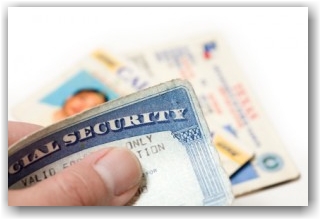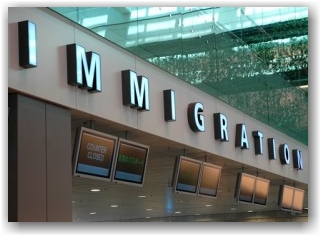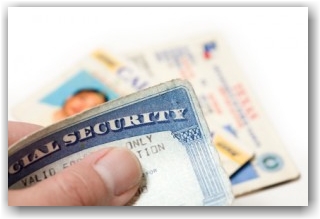Archive for the ‘Social Security’ Category
Thursday, October 17th, 2013
E-Verify has resumed operations following the federal government shutdown. All E-Verify features and services are now available.
The following information addresses questions on how the federal government’s shutdown affected E-Verify and Form I-9.
Information For Employers
Form I-9
The Form I-9 requirements were not affected during the federal government shutdown. All employers must complete and retain a Form I-9 for every person hired to work for pay in the United States during the shutdown.
E-Verify
Employees who received a Tentative Nonconfirmation (TNC)
If an employee had a TNC referred between September 17, 2013 and September 30, 2013 and was not able to resolve the TNC due to the federal government shutdown, add 12 federal business days to the date printed on the ‘Referral Letter’ or ‘Referral Date Confirmation.’ Employees have until this new date to contact the Social Security Administration (SSA) or the Department of Homeland Security (DHS) to resolve their cases. If you have an employee who decided to contest his or her TNC while E-Verify was unavailable, you should now initiate the referral process in E-Verify. Employers may not take any adverse action against an employee because of a TNC.
Employees who received a SSA Final Nonconfirmation (FNC) or DHS No Show result
If an employee received a Final Nonconfirmation (FNC) or No Show because of the federal government shutdown, please close the case and select “The employee continues to work for the employer after receiving a Final Nonconfirmation result,” or “The employee continues to work for the employer after receiving a No Show result.” The employer must then enter a new case in E-Verify for that employee. These steps are necessary to ensure the employee is afforded the opportunity to timely contest and resolve the Tentative Nonconfirmation (TNC) that led to the FNC result.
Creating Cases: Three-Day Rule
You must create an E-Verify case for each employee hired during or otherwise affected by the shutdown by November 5, 2013. If you are prompted to provide a reason why the case is late (i.e., does not conform to the three-day rule), select ‘Other’ from the drop-down list of reasons and enter ‘federal government shutdown’ in the field. Federal Contractor
Deadlines
During the federal government shutdown, federal contractors could not enroll or use E-Verify as required by the federal contractor rule. If your organization missed a deadline because E-Verify was unavailable or if it has an upcoming deadline for complying with the federal contractor rule, please follow the instructions above and notify your contracting officer of these instructions.
Information For Employees
If the federal government shutdown prevented you from contesting a Tentative Nonconfirmation (TNC), you will be allowed additional time to contact the Social Security Administration (SSA) or Department of Homeland Security (DHS). If your TNC was referred between September 17, 2013 and September 30, 2013, and you were not able to resolve the mismatch due to the federal government shutdown, you should:
- Add 12 federal business days to the date printed on the ‘Referral Letter’ or ‘Referral Date Confirmation’ that your employer provided you after you contested the TNC. Federal business days are Monday through Friday and do not include federal holidays.
- Contact SSA or DHS by the new date to resolve your TNC.
If you received a Final Non-Confirmation (FNC) because you could not contact DHS or SSA during the federal government shutdown, or because you could not contact DHS or SSA in the first ten days after the government reopened, please contact your employer and request that the employer re-enter your query. For more information about contesting your TNC or FNC, please refer to Employee section of the E-Verify website.
Customer Support
E-Verify Customer Support expects an increase in requests for assistance. Due to this increase, customers may experience longer than normal delays and response times. We apologize for any inconvenience and appreciate your patience. For any questions or additional information about how the federal shutdown affects E-Verify, please email E-Verify@dhs.gov. For questions about Form I-9, please visit I-9 Central or email I-9Central@dhs.gov. Employers and employees may also contact E-Verify at 888-464-4218. Customer Support representatives are available Monday through Friday 8:00 am to 5:00 pm local time.
If you would like to become a client of our office or have any questions psertaining to this blog post, please give us a call.
Tags: DOL, E-Verify, E-Verify after Shutdown, Employment Eligiblity Verification, FNC, I-9, I-9/E-Verify News, Legal Workforce, OSC, SSA, TNC, USCIS
Posted in Employer Compliance, I-9/E-Verify News, ICE, Immigration News, OSC, Social Security, USCIS | Comments Off on E-Verify Now Open and Provides Instructions on Shutdown Issues for New Hires, TNCs and FNCs
Thursday, October 10th, 2013

On June 15, 2012, President Obama signed a memo calling for deferred action for certain undocumented young people who came to the U.S. as children and have pursued education or military service here. Applications under the program which is called Deferred Action for Childhood Arrivals (“DACA”) began on August 15, 2012. Individuals that meet particular criteria, are awarded employment authorization (a/k/a an “EAD Card”) by USCIS.
USCIS does not alert employers when EAD cards have been issued to existing employees, and the employee is under no obligation to present the document to the employer. However, should they do so, the employer is obligated to examine the document.
The Attached Fact Sheet identifies the employer’s obligations during the Form I-9 process and provides specific guidance to employers on the treatment of EADs issued by USCIS to DACA recipients, whether they be current employees who come forward on their own, or new hires.
Note that DACA guidance does not direct employers to perform E-Verify queries on current employees who present DACA work authorization. Rather, it states that employers should complete a new Form I-9 and perform an E-Verify query in certain situations involving material changes to identity information. More on this topic can be found in the new M-274 Handbook on pages 23-24.
Should you like to become a client of our office or have particular questions pertaining to this topic, please feel free to contact us.
Tags: DACA, DACA EAD Cards, DACA Fact Sheet, DOL, E-Verify, EAD Employment Authorization, I-9 AUDIT, I-9 Form, I-9 Reverification, I-9 Training, I-9/E-Verify News, ICE, Immigration News, Legal Workforce, M-274, OSC, SSA, USCIS
Posted in DACA | DAPA, Department Of Homeland Security (DHS), Department Of Labor (DOL), Employer Compliance, I-9/E-Verify News, ICE, Immigration News, OSC, Social Security | Comments Off on Form I-9 Processing for DACA Recipients
Sunday, October 6th, 2013
 The Immigration and Nationality Act (“INA”) prohibits employers from discriminating against individuals based on their citizenship or immigration status, or based on their national origin, in the Form I-9 process. It is important for employers to develop, implement and enforce anti-discrimination policies, practices and procedures, and to ensure that all employees conducting Form I-9 verification or E-Verify confirmation understand all program rules. Employers should also provide appropriate and adequate employee education on employer responsibilities and worker rights.
The Immigration and Nationality Act (“INA”) prohibits employers from discriminating against individuals based on their citizenship or immigration status, or based on their national origin, in the Form I-9 process. It is important for employers to develop, implement and enforce anti-discrimination policies, practices and procedures, and to ensure that all employees conducting Form I-9 verification or E-Verify confirmation understand all program rules. Employers should also provide appropriate and adequate employee education on employer responsibilities and worker rights.
To prevent discrimination, employer’s should treat all people equally when
- announcing a job
- taking applications
- performing interviews
- making job offers
- verifying the individual’s authorization to work
- hiring the individual
- terminating the individual’s employment
Employers also must not retaliate against a person who
- files a charge of discrimination with OSC or EEOC
- participates in an investigation or prosecution of a discrimination complaint
- asserts his or her rights or the rights of another person under anti-discrimination laws
The Department of Justice’s Office of Special Counsel for Immigration-Related Unfair Employment Practices (OSC) investigates charges of employment discrimination related to an individual’s citizenship or immigration status or national origin. The Equal Employment Opportunity Commission (EEOC) also investigates employment discrimination based on national origin, in addition to other protected bases. OSC investigates national origin claims against employers with four to 14 employees, and EEOC investigates national origin claims against employers with 15 or more employees.
There has been a high level of enforcement by OSC this year concerning the anti-discrimination provision, with three more cases recently publicized in the last month:
- OSC settled with Texas-based Infinity Group who required non-citizens present specific DHS-issued documents such as green-cards or employment authorization to establish identity and employment authorization while similarly not requesting the same of US citizens. They were fined $53,000, had to pay $35K in back pay to those who were damaged as a result of their practices.
- OSC settled with PA-based Huber Nurseries for engaging in citizenship discrimination by preferring to hire temporary H-2A visa holders over Permanent Residents (green-card holders). Huber has agreed to pay $2,250 in civil penalties to the USA and $59,617 in back pay to the six injured parties, who are former refugees; and
- OSC settled with IBM for violating the anti-discrimination provision for placing online job postings for software developers with a preference for F-1 and H-1B visa holders. IBM has agreed to pay $44,400 in civil penalties to the USA.
So, what’s an employer to do?
Employers must accept all documents that are indicated on the List of Acceptable Documents to complete the I-9 form as long as they appear reasonably genuine on their face and relate to the employee. For example, all individuals who possess a driver’s license and unrestricted Social Security card may present those documents to satisfy Form I-9 requirements. Employers may not request or require potential employees to produce “green cards” or United States citizens who look or sound “foreign” to produce birth certificates. The employee chooses which of the acceptable Form I-9 documents to present. Employers must assure that those charged with the responsibility of I-9 management are trained on I-9 regulations and the anti-discrimination provision of the INA – and they must not
- Demand that an employee show specific documents
- Ask to see employment authorization documents before an individual accepts a job offer
- Refuse to accept a document, or refuse to hire an individual, because a document will expire in the future
- Refuse to accept a receipt that is acceptable for Form I-9 purposes
- Demand a specific document when reverifying that an employee is authorized to work
We recommend that you take some time and read the OSC’s Guide to Fair Employment that can be accessed here, that contains some thought provoking What would you do? scenarios that start on page 6.
Should you have questions or require particular guidance on this topic, please feel free to contact our office.
Tags: Department Of Homeland Security (DHS), E-Verify, Employment Practices, Hiring Practices, I-9 Audits, I-9 management, I-9 Penalties, I-9/E-Verify News, ICE, ICE Fines, Immigration News, INA Anti-Discrimination Provision, Legal Workforce, OSC, SSA
Posted in Department Of Homeland Security (DHS), Employer Compliance, I-9/E-Verify News, ICE, OSC, Social Security, USCIS | Comments Off on I-9/E-Verify: Preventing Discrimination in Hiring Practices
Friday, September 27th, 2013

USCIS has indicated that not all SSA documents referring to the ownership of the SSA account or reflecting an application for a new card, are valid receipts for the I-9 process. So, what constitutes a valid SSA replacement receipt?
The only receipt from SSA that is acceptable under the receipt rule is a receipt that states “This is a receipt to show you applied for a social Security Card and the application was for a lost, stolen or damaged document.” Any other receipt would not be acceptable. Your employee may present a receipt for the application for the replacement of any List A, List B, or List C document. The receipt is valid for 90 days. When it expires, the employee must show you the replacement document for which the receipt was given.
After the receipt expires, you should:
1) Cross out the word “receipt” and any accompanying document number
2) Record the number and other required document information from the actual document presented.
3) Initial and date the change.
You cannot accept a receipt for the I-9 Form for an initial or renewal employment authorization, but can accept a receipt for the application for replacement of a lost, stolen or damaged employment authorization document. You cannot accept receipts if employment will last less than three days.
The Three-Day Business Rule
Q: How does an employer that is operational over the weekend but whose HR office (which is open during regular business hours but closed on weekends) count the 3-business days for I-9 purposes?
A: Employers are required to complete the I-9 Form within 3 business days of the employees first day of work for pay. If the business is operational on the weekends, this counts towards the 3 day timeframe for I-9 completion. Thus, in order to remain in compliance for businesses that operate on the weekends, we suggest that the first day of work for pay be on a week day when the HR office representatives who are trained in I-9 procedures are available.
Tags: I-9 Form, I-9 process, I-9 Receipt Rule, I-9 Three-Day Rule, I-9/E-Verify News, ICE, Immigration News, Legal Workforce, OSC, Social Security Cards, SSA, USCIS
Posted in Employer Compliance, I-9/E-Verify News, ICE, Immigration News, OSC, Social Security, USCIS | Comments Off on I-9 Form Guidance: Social Security Replacement Receipts and the Three Day Business Rule
Sunday, September 22nd, 2013
 Answers to questions from April 2013 by the American Immigration Lawyer’s Association (AILA) to USCIS Verification Division/Washington, DC re the new I-9 Form, its Instructions, the M-274 Handbook and the I-9 Central website have finally been answered. We will be featuring several of the Q&A’s this week and trust that you will find this both enlightening and informative.
Answers to questions from April 2013 by the American Immigration Lawyer’s Association (AILA) to USCIS Verification Division/Washington, DC re the new I-9 Form, its Instructions, the M-274 Handbook and the I-9 Central website have finally been answered. We will be featuring several of the Q&A’s this week and trust that you will find this both enlightening and informative.
Today, we deal with new name change directives and guidance – Page 23 of the Employer Handbook. In the case of a divorce, it is recommended even where there is no rehire or reverification in order that the employer’s actions are well documented if the government asks to inspect your Forms I-9.
Question: Can USCIS Verification confirm that the only time an employer is required to record a legal name change is in connection with a rehire or reverificaton? In addition, does USCIS intend, by its advice to take steps to be reasonably assured of the employee’s identity and the veracity of the employee’s claim of a legal name change to require female employees to produce marriage licenses or divorce decrees after a change in marital status? To what extent has Verification discussed this change in guidance with OSC or the EEOC to ensure that it is not inconsistent with anti-discrimination provisions?
Answer: Page 24 of the Employer Handbook contains new guidance for employers dealing with a situation where a current employee comes forward with documentation of a new identity. The Handbook states that the employer should complete a new I-9 form, list the original hire date, and provide a written explanation of the circumstances giving rise to the new I-9-. Although we agree that completion of a new I-9 may be the best practice in certain circumstances, requiring employers to complete a new I-9 for existing employees who provide updated identity documentation appears to be at odds with the statute and regulations that require an I-9 only upon “hire.”
The legal basis for the guidance in the Handbook in certain circumstances is based on the INA that refers to the prohibition against continuing to employ an alien knowing that they are unauthorized to work.
An example of this might be presentation to the employer of a new Social Security Card reflecting a new Social Security number and new name which raises material questions as to the identity of the employee, the veracity of information on Form I-9, the genuineness of any documents presented in Section 2 that contain a Social Security number, and the relation of these documents to the person who presented them. The employer can no longer reasonably rely on the Form I-9 to be assured that the individual is authorized to work. In this scenario, USCIS suggests completion of a new Form I-9 to ensure the employee is eligible to continue in employment. This is a suggestion, and not a requirement.
Our office agrees with this position and recommends filling out a new I-9 form. Should you have any questions concerning this guidance, please contact our office at Info@immigrationcompliancegroup.com or call 562 612.3996.
Tags: I-9 AUDIT, I-9 Document Examination, I-9 Folrm Name Changes, I-9 Form Instructions, I-9 Form Penalties, I-9 Reverification, I-9 Violations, I-9/-Verify News, I-9/E-Verify News, ICE, Immigration News, Legal Workforce, OSC, Social Security, USCIS
Posted in Employer Compliance, I-9/E-Verify News, ICE, Immigration Legislation, OSC, Social Security, USCIS | Comments Off on USCIS Provides Answers to New I-9 Form Questions
Monday, September 9th, 2013

USCIS has gone ‘live’ day with a new TNC communication process. The highlight of the latest enhancement is the combining of the TNC Notice and Referral Letter into one document – the Further Action Notice.
The Further Action Notice simplifies the TNC communication process by combining the employee’s biographical information, the reason for the TNC, the employee’s decision to contest, and employee instructions for contesting a TNC into a single document. There will also be fewer screens to click through.
Here is a chart that provides the action that needs to be taken in various different TNC scenarios — very helpful, as well as a Further Action Notice sample, and a new email notification that will be sent to employees when their cases are referred to SSA or DHS.
Tags: Department Of Homeland Security (DHS), E-Verify Employee Email, E-Verify Further Action Notice, E-Verify TNC Enhancement, I-9, I-9 Compiance, I-9/E-Verify, I-9/E-Verify News, ICE, Immigration News, Legal Workforce, SSA, USCIS
Posted in Department Of Homeland Security (DHS), Employer Compliance, I-9/E-Verify News, ICE, Immigration News, Social Security, USCIS | Comments Off on E-Verify Releases New TNC Enhancements
Monday, June 17th, 2013

After considering some 200 amendments to the Gang of 8’s immigration bill entitled the Border Security, Economic Opportunity, and Immigration Modernization Act of 2013 (a/k/a CIR, or Comprehensive Immigration Reform), it survived the Senate Judiciary Committee overhaul and has been introduced onto the floor of the Senate for further debate taking place this month. It is the goal of the Senate to complete their work on the Bill by the July 4th recess. On the weekend talk show circuit, Lindsay Graham (S-SC) told conservatives who are trying to block the measure that they will doom the party. Sen. Robert Menendez, D-N.J., went a step further and predicted “there will never be a road to the White House for the Republican Party if immigration overhaul fails to pass.”
The big question is – will the House of Representatives cooperate and pass a bill? The theory on this is that the purpose of the legislative process right now is for the House to get a bill passed. It could be a good or bad bill; it just has to be an intact bill because once something makes it through the House, it will go to conference with the Senate and the Committee will compare the two bills and draft a compromise bill that both chambers can accept
The Temperature on Immigration Reform in the House of Representatives:
While many House conservatives agree immigration reform is a critical priority for Congress, they part with President Obama, Senate Democrats, and some in their own party who believe allowing eventual citizenship to those in the country illegally is part of the solution. They vow that they won’t support any bill that adds to the deficit and they want to see a tougher approach to border security and to the benefits issue.
Not only has the federal government consistently increased spending on border enforcement, it has also met the border-security benchmarks laid down in the three immigration-reform bills introduced in the Senate since 2006. Read more on border security here
The GOP insists that newly legalized workers now working in the shadows have no access to government-sponsored health care during their 15-year pathway to citizenship. Democrats say that since these newly legalized immigrants would be paying taxes (millions already do pay taxes), they should be eligible for benefits.
In the end, both chambers of Congress must eventually pass the identical legislation for the bill to make its way to the President’s desk to become law. The question is…Will House Republican leadership pass a bill or fail?
White House Official stated to the Daily Caller, “If a Gang of Eight-style bill is signed into law by the President, it will probably be one of the top five legislative accomplishments in the last twenty years.”
For a Summary of S 744 refer here. Refer here for more on the progress of S. 744 in the Senate, the text of bill, the summary and the proposed amendments.
The House Judiciary Committee markup of the bill starts this week, and will start with SAFE Act (H.R. 2278), a bill to improve the interior enforcement of our immigration laws and strengthen national security and will then take up the AG Act (H.R. 1773), a bill to provide American farmers with a workable temporary agricultural guest worker program that will help provide access to a reliable workforce. Read more here
Tags: Agricultural Workers, Blue Card, border security, Border Security Economic Opportunity and Immigration Modernization Act of 2013, CIR, Comprehensive Immigration Reform, Congress, DACA, E-Verify, Employment Eligibility Verification, H-1B, Immigrant Benefits, Immigration Reform, S. 744, W visa
Posted in Agriculture, Comprehensive Immigration Reform, Congress, DACA | DAPA, Employer Compliance, H-1B Visas, Immigration Legislation, Immigration News, Social Security | Comments Off on The Heavy Lift of Immigration Reform
Tuesday, May 7th, 2013
 USCIS Will not Accept Previous Versions of Form I-9 as of May 7, 2013
USCIS Will not Accept Previous Versions of Form I-9 as of May 7, 2013
USCIS reminds employers that beginning today, May 7, 2013, they must use the revised Form I-9, Employment Eligibility Verification (Revision 03/08/13)N for all new hires and reverifications. All employers are required to complete and retain a Form I-9 for each employee hired to work in the United States.
The revision date of the new Form I-9 is printed on the lower left corner of the form. Employers should not complete a new Form I-9 for existing employees, however, if a properly completed Form I-9 is already on file.
A Spanish version of Form I-9 (revision 03/08/13)N is available on the USCIS website for use in Puerto Rico only. Spanish-speaking employers and employees in the 50 states, Washington, D.C., and other U.S. territories may use the Spanish version for reference, but must complete and retain the English version of the form.
The revised forms are available online at www.uscis.gov/I-9. USCIS has also offering free webinars to help employers learn about the new form. To order forms, call USCIS toll-free at 1-800-870-3676. For free downloadable forms and information on USCIS programs, immigration laws, regulations, and procedures, please visit www.uscis.gov and go to the ‘forms’ menu or I-9 Central
Tags: Employment Eligibility Verification, I-9/E-Verify News, I-9/E-Verify News, ICE, Immigration Compliance Group, Immigration News, Immigration Reform, Legal Workforce, M-274 Employer Handbook, New I-9 Form, Social Security
Posted in Employer Compliance, I-9/E-Verify News, ICE, Immigration Legislation, Immigration News, Social Security | Comments Off on Employers Must Use Revised Form I-9, Employment Eligibility Verification Form
Thursday, March 14th, 2013

A new edition of the I-9 employment eligibility verification form was introduced last week. USCIS has been working on the revised I-9 form for more than a year. The revised M-274 Handbook for Employers can be accessed at the same link. Many areas on the I-9 Central website have also been updated. Note the webinar schedule for the new form.
The new edition of the I-9 Form, dated March 8, 2013, will take effect immediately on publication and will become the only acceptable version of the form. Employers who need to make necessary updates to their business processes to allow for use of the new Form I-9 may continue to use other previously accepted revisions (Rev.02/02/09)N and (Rev. 08/07/09)Y until May 6, 2013. Effective May 7, 2013, all employers must use the revised Form I-9 for each new employee hired in the United States. Employers who are not using the I-9 form following the 60-day grace period will be subject to fines and penalties under 274(a) of The Act (The Immigration and Nationality Act), IRCA, as well as ICE.
The revised Form I-9 has several new features, including new fields and a new format to reduce errors, and more clearly describes the information employees and employers must provide in each section. The instructions to the form are now 7 pages in length, and we recommend that you provide the instructions and the list of documents to your new employees to refer to during the process. The form looks much more official and now displays the DHS seal at the top left of the form with space built in to eventually implement future barcode technology. Helpful new images have been added to the M-274 Handbook to illustrate how employees and employers can complete Sections 1-3 of the new form. Please also see page 23 for updated guidance on recording changes of name and other identity guidance.
In the USCIS Stakeholder conference held on March 11, 2013, many of the questions centered around the following topics that we thought might be helpful to share with you, as follows:
- Do I need to fill out a new I-9 forms for all employees? You do not need to do new I-9 forms for those employees who already have one.
- When to accept receipts: Receipts for initial employment or renewal (during reverification) of employment are not acceptable. There are 3 different documents that qualify as receipts are: (a) Receipts may be presented for sections 2 and 3 if the document was lost, stolen or damaged; the receipt is valid for 90 days. (b) Temporary I-551 (a printable notation on a machine-readable immigrant visa inside a foreign passport). This is a 1-year permanent residency stamp for a foreign national that has received permanent status abroad. The Form I-551 (permanent residency card) must be presented prior to or no later than the expiration stamp inside the passport. (c) An I-94 entry card with an unexpired refugee stamp. This is considered a receipt for an Employment Authorization Document (EAD card), or a combination of an unrestricted Social Security Card and a List B document and is valid for 90 days.
- Rehires and Reverifications: If you are rehiring an employee who completed an I-9 form within 3 years, you can continue to use the existing I-9 form, and record any name changes, the rehire date and other required information in Section 3 and change the date of hire in Section 2 (initial/date). If their work authorization as changed you can make the correction on the existing form if still valid or generate a new form I-9 and fill in Section 3 and attach to the old form. As a reminder, do not reverify US citizens, permanent residents, conditional residents, asylees with unrestricted work authorization and List B identity documents such as driver’s licenses and state ID cards.
- The use of notaries: Notaries are “designated agents” of the employer. They should not imprint their notary stamp on any I-9 documentation or attach same to the I-9 form. The employer is responsible for their actions and any violations relating to Form I-9. Photocopies of I-9 forms are also not acceptable from Notaries. A notary or any other designated agent appointed by the employer must examine the original documents presented to them and thoroughly complete and sign section 2 of the form and return the original to the employer, along with photocopies of the presented documents should this be a company policy.
- Recording social security numbers: On the List of Acceptable Documents for List C, Social Security card restrictions are explained to better assist in examination of the document. Note that individuals with temporary work authorization are issued restricted social security cards that indicate: “Not valid without USCIS/DHS work authorization
- Recording the date of hire in Section 2: When an offer of employment is extended and accepted but the employee has not yet started, the I-9 may be completed using that date instead of the ‘actual’ start date of employment. You may then go back into the form and adjust the date to the actual start date (the 1st day of work for pay). Recruiters or recruiters for a fee are not required to enter the employee’s first day of employment. However, you may enter the first day the employee was placed in a job pool after an offer of employment and acceptance.
- Must employee present documents that correspond to box checked in Section 1? No, employers may not insist on viewing any particular documents. However, if information is recorded in section 1 that puts the employer “on notice” that work authorization may be expiring, you are required to track that date and follow-up with the employee concerning their continued work authorization.
USCIS has indicated that a good place to begin implementing the use of the new I-9 form is to take time to first thoroughly read and digest the revised M-274 Handbook for Employers. Download it from the USCIS website and provide a complete copy to each and every employee charged with processing and managing the I-9 function at your place of employment to ensure that they are aware of the changes and are equipped to properly implement them. Update your company policies to reflect the changes in the form.
For those of you who manage your I-9 forms via an electronic software vendor, this is absolutely the right time to have a conversation with them concerning their compliance with the new form and make sure that it complies with all pertinent rules and regulations for I-9 electronic software . This is also an excellent time to think about additional training for your staff. Refer here for our services and solutions.
To order copies of the new I-9 form from USCIS, you can call 1-800-870-3676.
Tags: Changes to new I-9 Form, Department Of Homeland Security (DHS), Department Of Labor (DOL), Employer Sanctions, Employment Eligibility Verification, Handbook for Employers, I-9 AUDIT, I-9 Form Penalties, I-9 Training, I-9/E-Verify News, ICE, Immigration News, Legal Workforce, M-274, New I-9 Form, Social Security, USCIS
Posted in Department Of Homeland Security (DHS), Department Of Labor (DOL), Employer Compliance, I-9/E-Verify News, ICE, Immigration Legislation, Immigration News, Social Security, Staffing Agencies, USCIS | Comments Off on New I-9 Form Update from Immigration Compliance Group
Thursday, March 7th, 2013
 A new edition of the I-9 employment eligibility verification form has been introduced today and has been published in the Federal Register as of this writing. USCIS has been working on the revised I-9 form for more than a year. In March 2012, it published a proposed revision for public comment.
A new edition of the I-9 employment eligibility verification form has been introduced today and has been published in the Federal Register as of this writing. USCIS has been working on the revised I-9 form for more than a year. In March 2012, it published a proposed revision for public comment.
The new edition, dated March 8, 2013, will take effect immediately on publication and will become the only acceptable version of the form. Employers who need to make necessary updates to their business processes to allow for use of the new Form I-9 may continue to use other previously accepted revisions (Rev.02/02/09)N and (Rev. 08/07/09)Y until May 7, 2013. After May 7, 2013, all employers must use the revised Form I-9 for each new employee hired in the United States. Employers who are not using the I-9 form following the 60-day grace period will be subject to fines and penalties under 274(a) of The Act (The Immigration and Nationality Act), IRCA, as well as ICE.
The revised Form I-9 has several new features, including new fields and a new format to reduce errors. The instructions to the form also more clearly describe the information employees and employers must provide in each section. To order copies of the new I-9 form from USCIS, you can call 1-800-870-3676.
For those of you who manage your I-9 forms via an electronic software vendor, this is absolutely the right time to have a conversation with them concerning their compliance with the new form. This is also a good time to think about additional training for your staff. Refer here for our services and solutions. We will be reviewing the form very carefully in the next few days and will post our comments and guidance.
Tags: Employment Eligibility Verification, I-9 Form, I-9/E-Verify News, ICE, Immigration News, Immigration Reform, New I-9 Form, Social Security, USCIS
Posted in I-9/E-Verify News, ICE, Immigration Legislation, Immigration News, Social Security, USCIS | Comments Off on NewsFLASH —— New I-9 Form Released March 8, 2013








